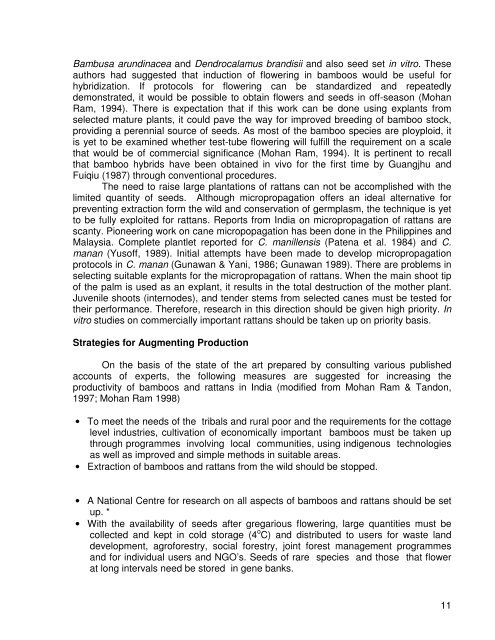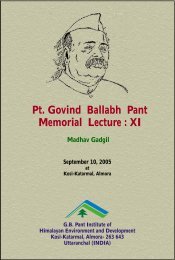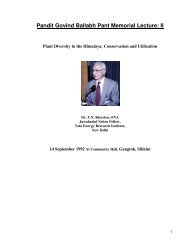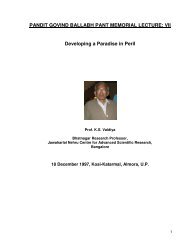Complete Lecture - Govind Ballabh Pant Institute of Himalayan ...
Complete Lecture - Govind Ballabh Pant Institute of Himalayan ...
Complete Lecture - Govind Ballabh Pant Institute of Himalayan ...
You also want an ePaper? Increase the reach of your titles
YUMPU automatically turns print PDFs into web optimized ePapers that Google loves.
Bambusa arundinacea and Dendrocalamus brandisii and also seed set in vitro. Theseauthors had suggested that induction <strong>of</strong> flowering in bamboos would be useful forhybridization. If protocols for flowering can be standardized and repeatedlydemonstrated, it would be possible to obtain flowers and seeds in <strong>of</strong>f-season (MohanRam, 1994). There is expectation that if this work can be done using explants fromselected mature plants, it could pave the way for improved breeding <strong>of</strong> bamboo stock,providing a perennial source <strong>of</strong> seeds. As most <strong>of</strong> the bamboo species are ployploid, itis yet to be examined whether test-tube flowering will fulfill the requirement on a scalethat would be <strong>of</strong> commercial significance (Mohan Ram, 1994). It is pertinent to recallthat bamboo hybrids have been obtained in vivo for the first time by Guangjhu andFuiqiu (1987) through conventional procedures.The need to raise large plantations <strong>of</strong> rattans can not be accomplished with thelimited quantity <strong>of</strong> seeds. Although micropropagation <strong>of</strong>fers an ideal alternative forpreventing extraction form the wild and conservation <strong>of</strong> germplasm, the technique is yetto be fully exploited for rattans. Reports from India on micropropagation <strong>of</strong> rattans arescanty. Pioneering work on cane micropopagation has been done in the Philippines andMalaysia. <strong>Complete</strong> plantlet reported for C. manillensis (Patena et al. 1984) and C.manan (Yus<strong>of</strong>f, 1989). Initial attempts have been made to develop micropropagationprotocols in C. manan (Gunawan & Yani, 1986; Gunawan 1989). There are problems inselecting suitable explants for the micropropagation <strong>of</strong> rattans. When the main shoot tip<strong>of</strong> the palm is used as an explant, it results in the total destruction <strong>of</strong> the mother plant.Juvenile shoots (internodes), and tender stems from selected canes must be tested fortheir performance. Therefore, research in this direction should be given high priority. Invitro studies on commercially important rattans should be taken up on priority basis.Strategies for Augmenting ProductionOn the basis <strong>of</strong> the state <strong>of</strong> the art prepared by consulting various publishedaccounts <strong>of</strong> experts, the following measures are suggested for increasing theproductivity <strong>of</strong> bamboos and rattans in India (modified from Mohan Ram & Tandon,1997; Mohan Ram 1998)• To meet the needs <strong>of</strong> the tribals and rural poor and the requirements for the cottagelevel industries, cultivation <strong>of</strong> economically important bamboos must be taken upthrough programmes involving local communities, using indigenous technologiesas well as improved and simple methods in suitable areas.• Extraction <strong>of</strong> bamboos and rattans from the wild should be stopped.• A National Centre for research on all aspects <strong>of</strong> bamboos and rattans should be setup. *• With the availability <strong>of</strong> seeds after gregarious flowering, large quantities must becollected and kept in cold storage (4 o C) and distributed to users for waste landdevelopment, agr<strong>of</strong>orestry, social forestry, joint forest management programmesand for individual users and NGO’s. Seeds <strong>of</strong> rare species and those that flowerat long intervals need be stored in gene banks.11











